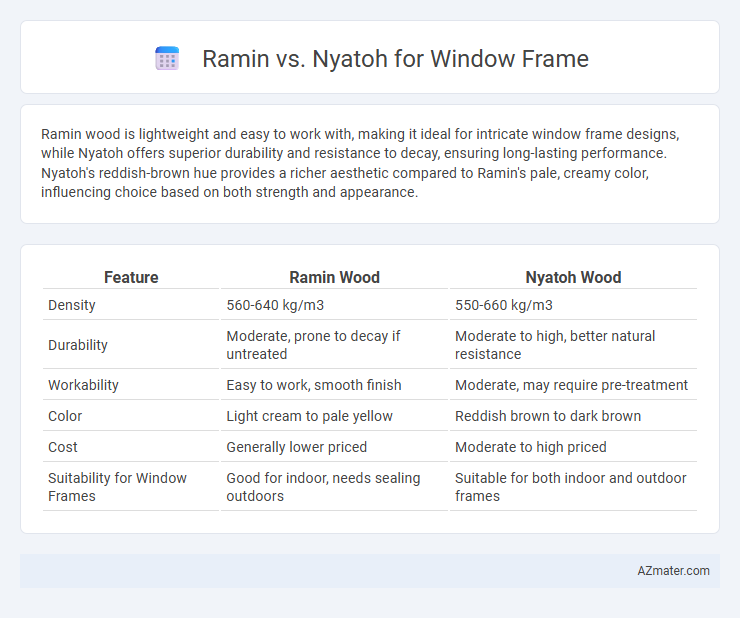Ramin wood is lightweight and easy to work with, making it ideal for intricate window frame designs, while Nyatoh offers superior durability and resistance to decay, ensuring long-lasting performance. Nyatoh's reddish-brown hue provides a richer aesthetic compared to Ramin's pale, creamy color, influencing choice based on both strength and appearance.
Table of Comparison
| Feature | Ramin Wood | Nyatoh Wood |
|---|---|---|
| Density | 560-640 kg/m3 | 550-660 kg/m3 |
| Durability | Moderate, prone to decay if untreated | Moderate to high, better natural resistance |
| Workability | Easy to work, smooth finish | Moderate, may require pre-treatment |
| Color | Light cream to pale yellow | Reddish brown to dark brown |
| Cost | Generally lower priced | Moderate to high priced |
| Suitability for Window Frames | Good for indoor, needs sealing outdoors | Suitable for both indoor and outdoor frames |
Introduction to Ramin and Nyatoh Wood
Ramin wood, sourced primarily from Southeast Asia, is prized for its light color, fine grain, and excellent workability, making it suitable for window frames requiring precision and a smooth finish. Nyatoh, derived from species in the Sapotaceae family native to Malaysia and Indonesia, features a reddish-brown hue with moderate hardness and good durability, offering a traditional aesthetic for window framing. Both woods provide distinct visual and physical properties, with Ramin favored for its pale, uniform appearance and Nyatoh valued for its rich color and strength.
Key Characteristics of Ramin Wood
Ramin wood is valued for window frames due to its pale yellow to light brown color, fine texture, and uniform grain, which provides an attractive and smooth finish. It exhibits moderate hardness and strength, making it durable and resistant to warping or cracking under changing weather conditions. Compared to Nyatoh, Ramin is lighter and easier to work with while maintaining sufficient stability for long-lasting window frame applications.
Key Characteristics of Nyatoh Wood
Nyatoh wood is favored for window frames due to its medium density and fine texture, providing a smooth finish that enhances aesthetic appeal. Its natural resistance to moisture and moderate durability makes it suitable for indoor applications where minimal exposure to harsh weather occurs. The wood's reddish-brown hue offers a warm, attractive look, while its workability allows for precise cutting and shaping during installation.
Durability Comparison: Ramin vs. Nyatoh
Ramin wood exhibits superior durability for window frames compared to Nyatoh, offering higher resistance to decay and insect attacks due to its dense grain structure. Nyatoh, while aesthetically appealing with its reddish-brown color, tends to have moderate durability and may require additional treatment to withstand outdoor conditions. Choosing Ramin ensures longer-lasting window frames in humid or exposed environments.
Appearance and Aesthetics
Ramin wood offers a light, uniform pale yellow to cream color with a smooth, fine grain, making it ideal for window frames with a clean and contemporary appearance. Nyatoh wood displays a richer reddish-brown hue and pronounced grain patterns, lending a warm and traditional aesthetic to window frames. The choice between Ramin and Nyatoh impacts the visual appeal significantly, whether aiming for subtle elegance or a more vibrant, rustic look.
Workability and Ease of Installation
Ramin wood offers superior workability for window frames due to its fine, even texture and straight grain, allowing for precise cutting and shaping with minimal splintering. Nyatoh, while durable, tends to be denser and harder, which can complicate installation by requiring more effort during cutting and fastening. The ease of installation with Ramin is notably higher, reducing labor time and improving fitting accuracy.
Resistance to Weather and Decay
Ramin wood offers moderate resistance to weather and decay, making it suitable for indoor window frames but less ideal for exterior use without proper treatment. Nyatoh exhibits better natural durability and stronger resistance to moisture and fungal decay, which enhances its performance in outdoor window frame applications. Both woods benefit from protective coatings, yet Nyatoh generally requires less maintenance in harsh weather conditions.
Environmental Impact and Sustainability
Ramin wood, sourced primarily from Southeast Asia, faces significant sustainability concerns due to overharvesting and habitat loss, leading to its classification as a vulnerable species by conservation groups. Nyatoh, also native to Southeast Asia, is widely used in window frames but often criticized for contributing to deforestation, though some certifications like FSC promote responsible harvesting practices. Choosing Nyatoh with verified sustainable sourcing reduces environmental impact more effectively than Ramin, which suffers from stricter regulatory restrictions and higher ecological risks.
Cost Analysis: Ramin vs. Nyatoh
Ramin wood generally offers a more cost-effective option for window frames compared to Nyatoh, with prices typically 20-30% lower due to its faster growth rate and greater availability. Nyatoh, renowned for its rich reddish-brown hue and durability, commands higher market prices often justified by its premium appearance and longer lifespan. When budgeting for window frames, choosing Ramin can significantly reduce upfront material expenses, but Nyatoh may offer better long-term value depending on environmental exposure and maintenance needs.
Best Choice for Window Frames: Ramin or Nyatoh?
Ramin wood offers a lightweight, fine-grained texture with excellent workability, making it ideal for precise window frame construction and ensuring stability in humid climates. Nyatoh, on the other hand, is denser and more durable, providing superior resistance to wear and impact but may require additional treatment to prevent warping. For window frames, Ramin typically stands out as the best choice due to its balanced combination of ease of machining, moderate durability, and dimensional stability in varying weather conditions.

Infographic: Ramin vs Nyatoh for Window Frame
 azmater.com
azmater.com